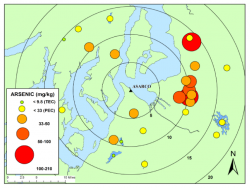by Jim Gawel, Ph.D., Erin Hull, Marco Barajas, Ken Burkart, Environmental Sciences, School of Interdisciplinary Arts and Sciences, University of Washington Tacoma & Rebecca Neumann, Ph.D., Alex Horner-Devine, Ph.D., Samantha Fung, Civil and Environmental Engineering, University of Washington Seattle
Arsenic, a priority Superfund contaminant and carcinogen, is a legacy pollutant impacting aquatic ecosystems in urban lakes downwind of the former American Smelting and Refining Company (ASARCO) copper smelter in Ruston, WA, now designated as the Commencement Bay/Nearshore Tideflats Superfund Site. A majority of Superfund sites are located in densely-settled areas; nationally, 139 of these sites have arsenic-contaminated surface waters. However, the human health and ecological implications of arsenic contamination are unclear due to an incomplete understanding of arsenic bioavailability in urban waters.
South King County contains numerous urbanized lakes located downwind of the former ASARCO smelter. The sediments of these lakes accumulated arsenic emitted by the smelter, and the lake sediments now represent a long-term source of contamination to surface water. Our initial mapping of arsenic contamination in lake sediments shows the extent of contamination in area lakes.
Our more recent work has focused on four lakes. Angle Lake (>200 ppm arsenic in sediments) and North Lake (85 ppm arsenic) are deeper, and Lake Killarney (>200 ppm arsenic) and Steel Lake (48 ppm arsenic) are shallow. Deeper lakes form layers of warm (surface) and cold (bottom) waters during the summer due to the sun’s heat, resulting in separate lake layers that do not mix, a process called stratification.
In Angle and North Lakes, which have strong seasonal stratification, high arsenic concentrations were limited to anoxic (no oxygen) bottom waters that formed during summer, and arsenic concentrations were low in oxygenated surface waters. However, in shallow Killarney and Steel Lakes, which have periodic summertime mixing of surface and bottom waters, the entire water column, including the fully oxygenated surface waters, had elevated concentrations of arsenic (up to 30 ppb) during the summer. In shallow Lake Killarney, summer warming increased temperatures at the lakebed surface, which in turn facilitated faster transport of arsenic across the sediment–water interface compared to the deep Angle Lake where the lakebed remained ~10°C cooler (Barrett et al. 2019).
As a result, we found greater transfer of arsenic through the base of the aquatic food web in the shallow lakes; plankton in shallow lakes accumulated up to 10x more arsenic on multiple sampling days than plankton in the deeper lakes with similar levels of sediment contamination. Aquatic life primarily inhabits oxygenated waters, so the greater bioaccumulation of arsenic in shallow lakes was likely due to elevated arsenic in oxygenated surface waters (Barrett et al. 2018). Our study indicates that mobilization of arsenic from lake sediments into overlying oxygenated water, which can occur in shallow lakes, leads to increased arsenic exposure and uptake at the base of the aquatic food web.
Because these lakes sustain varied freshwater organisms and are routinely fished by a diverse urban population, it is critical to understand not only how arsenic-contaminated lake waters develop, but also the effect they have on aquatic life and the potential risks they pose to human health. Currently we are sampling biological organisms in Angle Lake, Steel Lake, Lake Killarney, and Bonney Lake for arsenic uptake and toxicity. This summer we collected pumpkinseed sunfish and bluegills, crayfish, snails, plankton, aquatic plants, periphyton (attached algae), and related water and sediment samples.
We are currently analyzing those samples and will report those results in early 2020. We are also continuing work in Lake Killarney to better understand the temperature- and wind-driven mixing responsible for arsenic transport from the sediments to oxygenated surface waters. For this work we are collaborating with EPA Region 10 divers.
Sources:
Barrett, P.M., E.A. Hull, K. Burkart, O. Hargraves, J. McLean, R.B. Neumann, J.E. Gawel. 2019. Contrasting arsenic cycling in strongly- and weakly-stratified contaminated lakes: Evidence for temperature control on sediment-water arsenic fluxes. Limnology and Oceanography, 64: 1333-1346.
Barrett, P.M., E.A. Hull, C.E. King, K. Burkart*, K.A. Ott, J.N. Ryan, J.E. Gawel, R.B. Neumann. 2018. Increased exposure of plankton to arsenic in contaminated weakly-stratified lakes. Science of the Total Environment, 625: 1606-1614.
Gawel, J.E., J.A. Asplund, S. Burdick, M. Miller, S.M. Peterson, A. Tollefson, and K. Ziegler. 2014. Arsenic and lead distribution and mobility in lake sediments in the south-central Puget Sound watershed: The long-term impact of a metal smelter in Ruston, Washington, USA. Science of the Total Environment, 472: 530-537.v










